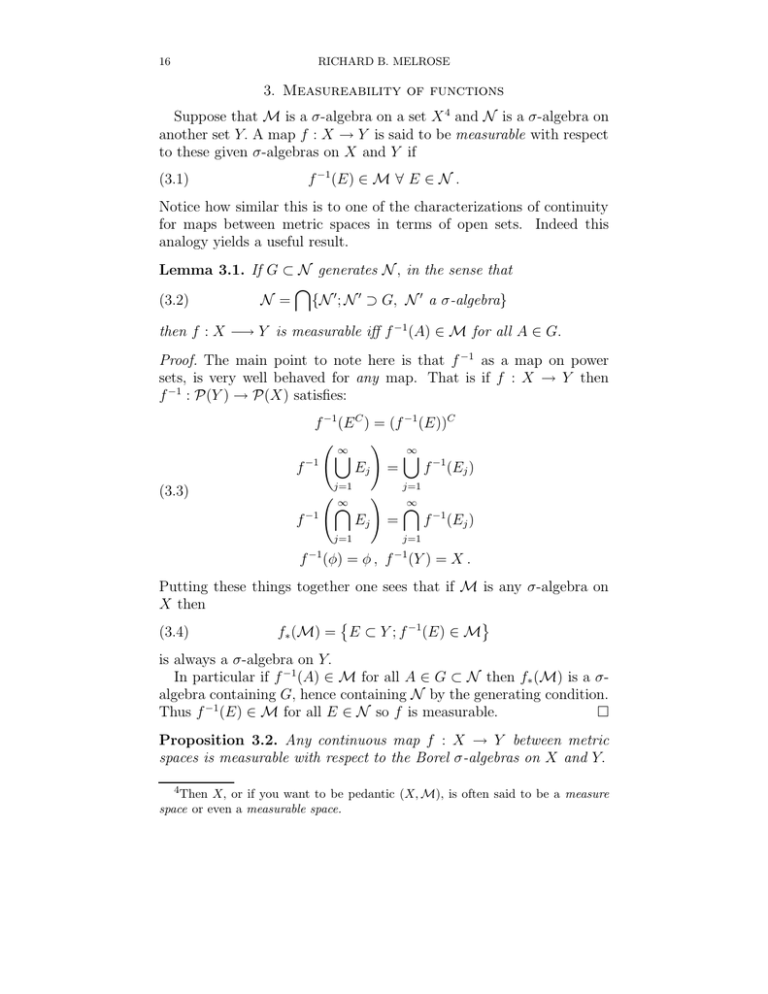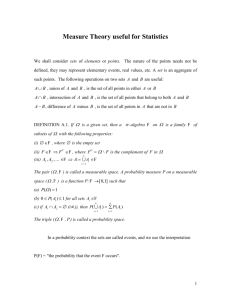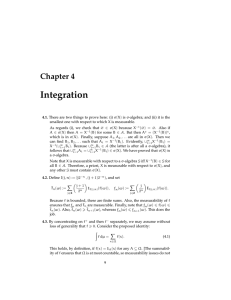3. Measureability of functions
advertisement

16
RICHARD B. MELROSE
3. Measureability of functions
Suppose that M is a �-algebra on a set X 4 and N is a �-algebra on
another set Y. A map f : X � Y is said to be measurable with respect
to these given �-algebras on X and Y if
f −1 (E) ≤ M � E ≤ N .
(3.1)
Notice how similar this is to one of the characterizations of continuity
for maps between metric spaces in terms of open sets. Indeed this
analogy yields a useful result.
Lemma 3.1. If G ∀ N generates N , in the sense that
�
(3.2)
N = {N ∗ ; N ∗ � G, N ∗ a �-algebra}
then f : X −� Y is measurable iff f −1 (A) ≤ M for all A ≤ G.
Proof. The main point to note here is that f −1 as a map on power
sets, is very well behaved for any map. That is if f : X � Y then
f −1 : P(Y ) � P(X) satisfies:
(3.3)
f −1 (E C ) = (f −1 (E))C
��
�
�
�
�
−1
f
Ej =
f −1 (Ej )
j=1
f
−1
��
�
j=1
f
−1
j=1
Ej
�
=
(�) = � , f
�
�
f −1 (Ej )
j=1
−1
(Y ) = X .
Putting these things together one sees that if M is any �-algebra on
X then
�
(3.4)
f� (M) = E ∀ Y ; f −1 (E) ≤ M
is always a �-algebra on Y.
In particular if f −1 (A) ≤ M for all A ≤ G ∀ N then f� (M) is a �algebra containing G, hence containing N by the generating condition.
Thus f −1 (E) ≤ M for all E ≤ N so f is measurable.
�
Proposition 3.2. Any continuous map f : X � Y between metric
spaces is measurable with respect to the Borel �-algebras on X and Y.
4Then
X, or if you want to be pedantic (X, M), is often said to be a measure
space or even a measurable space.
LECTURE NOTES FOR 18.155, FALL 2004
17
Proof. The continuity of f shows that f −1 (E) ∀ X is open if E ∀ Y
is open. By definition, the open sets generate the Borel �-algebra on
Y so the preceeding Lemma shows that f is Borel measurable i.e.,
f −1 (B(Y )) ∀ B(X).
�
We are mainly interested in functions on X. If M is a �-algebra
on X then f : X � R is measurable if it is measurable with respect
to the Borel �-algebra on R and M on X. More generally, for an
extended function f : X � [−⊂, ⊂] we take as the ‘Borel’ �-algebra
in [−⊂, ⊂] the smallest �-algebra containing all open subsets of R and
all sets (a, ⊂] and [−⊂, b); in fact it is generated by the sets (a, ⊂].
(See Problem 6.)
Our main task is to define the integral of a measurable function: we
start with simple functions. Observe that the characteristic function
of a set
�
1 x≤E
�E =
0 x≤
/E
is measurable if and only if E ≤ M. More generally a simple function,
(3.5)
f=
N
�
a i �E i , a i ≤ R
i=1
is measurable if the Ei are measurable. The presentation, (3.5), of a
simple function is not unique. We can make it so, getting the minimal
presentation, by insisting that all the ai are non-zero and
Ei = {x ≤ E ; f (x) = ai }
then f in (3.5) is measurable iff all the Ei are measurable.
The Lebesgue integral is based on approximation of functions by
simple functions, so it is important to show that this is possible.
Proposition 3.3. For any non-negative µ-measurable extended func­
tion f : X −� [0, ⊂] there is an increasing sequence fn of simple
measurable functions such that limn�� fn (x) = f (x) for each x ≤ X
and this limit is uniform on any measurable set on which f is finite.
Proof. Folland [1] page 45 has a nice proof. For each integer n > 0 and
0 ⊃ k ⊃ 22n − 1, set
En,k = {x ≤ X; 2−n k ⊃ f (x) < 2−n (k + 1)},
En∗ = {x ≤ X; f (x) → 2n }.
18
RICHARD B. MELROSE
These are measurable sets. On increasing n by one, the interval in the
definition of En,k is divided into two. It follows that the sequence of
simple functions
�
(3.6)
fn =
2−n k�Ek,n + 2n �En�
k
is increasing and has limit f and that this limit is uniform on any
measurable set where f is finite.
�



